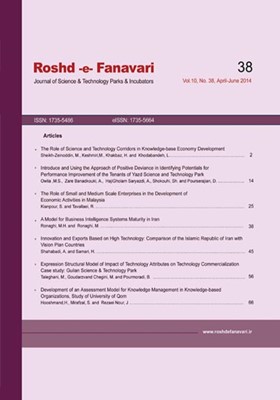-
-
List of Articles
-
Open Access Article
1 - The Role of Science and Technology Corridors in Knowledge-based Economy Development
Mahmod Sheykh Zeynaddin Hasan KIhakbaz Leyla Khodabandeh Mehdi Keshmiri -
Open Access Article
2 - Introduce and Using the Approach of Positive Deviance in Identifying Potentials for Performance Improvement of the Tenants of Yazd Science and Technology Park
Mohammad Saleh Oliua Ali Haji Gholam Sayazdi Abbas Zareu Benadkoki Shahram Shokohi Daruosh Pourserahian -
Open Access Article
3 - The Role of Small and Medium Scale Enterprises in the Development of Economic Activities in Malaysia
Saeed KiyanPour Roya Tolaei -
Open Access Article
4 - A Model for Business Intelligence Systems Maturity in Iran
MohammadHosein Ronaghi Marziyeh Ronaghi -
Open Access Article
5 - Innovation and Exports Based on High Technology: Comparison of the Islamic Republic of Iran with Vision Plan Countries
Abolfazll Shahabadi Haniyeh Samari -
Open Access Article
6 - Explanation of the Structural Model of the Impact of Technology Attributes on Technology Commercialization from the Viewpoint of the Managers of Knowledge-based Companies Case study: Guilan Science&Technology Park
Mohammad Taleghani Mehrdad Godarzvand Chegini Bahareh Pourmoradi -
Open Access Article
7 - Development of an Assessment Model for Knowledge Management in Knowledge-based Organizations Study of University of Qom
Haniyeh Hoshmand Somayeh Mir Afzal jalal rezaeenour
-
The rights to this website are owned by the Raimag Press Management System.
Copyright © 2017-2025







